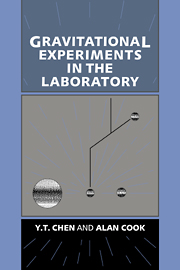Book contents
- Frontmatter
- Contents
- Preface
- 1 Introduction
- 2 The linear oscillator driven by thermal noise and with electrical damping
- 3 External sources of noise and design of experiments
- 4 The weak principle of equivalence
- 5 Verification of the weak principle of equivalence for free particles
- 6 Newtonian attractions of extended bodies
- 7 Experimental tests of the inverse square law
- 8 The constant of gravitation
- 9 Conclusion
- References
- Index
3 - External sources of noise and design of experiments
Published online by Cambridge University Press: 10 October 2009
- Frontmatter
- Contents
- Preface
- 1 Introduction
- 2 The linear oscillator driven by thermal noise and with electrical damping
- 3 External sources of noise and design of experiments
- 4 The weak principle of equivalence
- 5 Verification of the weak principle of equivalence for free particles
- 6 Newtonian attractions of extended bodies
- 7 Experimental tests of the inverse square law
- 8 The constant of gravitation
- 9 Conclusion
- References
- Index
Summary
Introduction
Thermal noise is unavoidable and sets the fundamental limit to the detectability of the response of an oscillator to any gravitational effect, but it is not the only disturbance to which an oscillator may be subject. Other forces may act on the mass of a torsion pendulum if it is subject to electric or magnetic or extraneous gravitational fields. The point of support of a torsion pendulum or other mechanical oscillator may be disturbed by ground motion. Ground motion is predominantly translational and so might be thought not to affect a torsion pendulum to a first approximation. However, all practical oscillators have parasitic modes of oscillation besides the dominant one, and although in linear theory normal modes are independent, in real non-linear systems modes are coupled. Thus, even if in theory seismic ground motion had no component of rotation about a vertical axis, none the less there would be some coupling between the primary rotational mode of a torsion pendulum and its oscillations in a vertical plane. In practice, therefore, any disturbance of a mechanical oscillator may masquerade as a response to a gravitational signal.
External sources of noise can be avoided with proper design of experiments. In this chapter we shall discuss both the sources of external disturbance and also the ways in which oscillators of different design respond.
Ground disturbance
Sources of ground noise
We begin with a discussion of seismic motions that move the point of support of a pendulum.
- Type
- Chapter
- Information
- Gravitational Experiments in the Laboratory , pp. 34 - 57Publisher: Cambridge University PressPrint publication year: 1993



